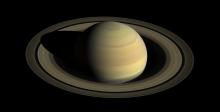Listen to today's episode of StarDate on the web the same day it airs in high-quality streaming audio without any extra ads or announcements. Choose a $8 one-month pass, or listen every day for a year for just $30.
You are here
Summer Solstice
For most of the year, the Sun’s path across the sky changes from day to day. It moves northward for about half of the year, and southward for the other half. But for a few days in June and December, the Sun’s path doesn’t move at all — it stands still.
Those times are the solstices, when the Sun appears farthest north or south for the year. And today marks the summer solstice — the start of summer in the northern hemisphere. It’s also the longest day of the year in the north — the longest gap between sunrise and sunset.
The Sun’s north-south motion across the sky is a bit of an illusion. The Sun doesn’t move at all. Instead, it’s our viewing angle that changes — the result of Earth’s tilt on its axis.
Our planet leans a bit with respect to its orbital path. So as Earth moves around the Sun, the poles take turns dipping toward and away from the Sun. Right now, the north pole is tipped sunward, so it’s summer in the northern hemisphere. And the pole itself is bathed in constant daylight.
At the winter solstice, in December, the north pole will tilt away from the Sun. It’ll be blanketed by darkness, while the south pole enjoys ’round-the-clock daylight.
Between those dates, the Sun rises and sets at different points along the horizon — far north in June, and south in December. For a few days around the solstices, though, its rising and setting points hardly move — the Sun comes to a standstill for the change of seasons.






